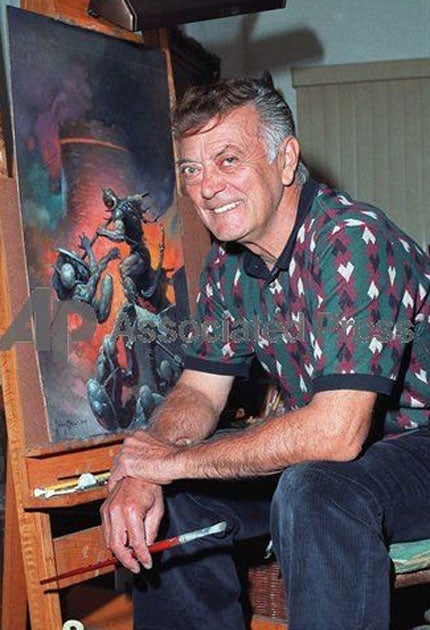Frank Frazetta: Influential artist who worked on the ‘Conan the Barbarian’, ‘Tarzan’ and ‘Li’l Abner’ comics

A hugely muscled barbarian brandishes a broadsword, defending an impossibly nubile maiden from some hideous enemy: Frank Frazetta's cover paintings for the paperback editions of Conan the Barbarian captured the essence of heroic fantasy, and were credited with turning Robert E Howard's pulp magazine stories into a best-selling franchise that eventually spawned the Arnold Schwarzenegger films.
Frazetta was one of the crucial comic-book artists of the post-war generation, despite doing few actual comics, and none after 1964. His influence can be seen most clearly in artists like Richard Corben or Bernie Wrightson. His insistence, from the early days, on keeping the rights to his originals was a groundbreaking move which took years to become industry standard. It was also profitable; the oil painting used as the cover to Conan The Conqueror sold at auction for $1m to the Metallica guitarist Kirk Hammett.
He was born Frank Frazzetta in Brooklyn in 1928 (he dropped a "z" from his surname to make it look less clumsy). His artistic talent was recognised by his first teachers, and at eight he enrolled at the Brooklyn Academy of Fine Arts. At 15 he was assisting John Giunta in Bernard Bailey's studio, where his first story, "Snowman", was published by Tally-Ho Comics. Even as he performed simple tasks like erasing and bordering for artists such as Graham Ingels and George Evans, the sketches flowing into his notebooks impressed them. Soon he was working for companies like Standard and Treasure, doing "funny animal" stories good enough for a job offer from Disney. He preferred to stay in New York, moving on to Westerns and adventure comics, and doing covers for Famous Funnies' Buck Rogers.
Sinewy and strong, Frazetta was a good enough baseball player to be offered a professional try-out by the New York Giants. He and Al Williamson, with whom he collaborated on John Wayne comics, organised fierce baseball games for fellow artists. They also passed work around. One day Frazetta picked up a story Williamson couldn't do. Squeeze Play, about a baseball game played with human body parts, became one of the prime exhibits in Frederic Wertham's 1954 indictment of comic books, Seduction of the Innocent.
Frazetta worked incessantly; creating Thun'da King of the Congo, ghosting Dan Barry's daily newspaper strip Flash Gordon, working on romance comics, and drawing his own daily strip, Johnny Comet. Frazetta prided himself on working from the imagination, without photos. "When I see something, I remember it," he said. "I see it from every perspective. I see the lighting... the drama... the peak action."
In 1954 he left the freelance grind to ghost the Sunday colour pages of Al Capp's hugely popular Li'l Abner newspaper strip. Abner, the muscle-bound hillbilly, was a Conan prototype, and Frazetta created Moonbeam McSwine, the impossibly lush dark-haired beauty out to lure Abner away from his true love, Daisy Mae. Working one day a week he earned more money than he had doing comics. In 1956 he married Eleanor Kelly on Sadie Hawkins Day, the day in Li'l Abner when women proposed to men, though he claimed it was coincidental. Capp pestered him to join his Boston studio and do the daily strip, but when after nine years he agreed, Capp cut the rate and Frazetta quit.
Freelance work now proved harder to find; Frazetta suspected Capp of blackballing him. He illustrated adult paperbacks, and men's magazines like Gent and Dude, and was helped by his old colleagues from EC Comics. Harvey Kurtzman hired him on Playboy's Little Annie Fannie, though Hugh Hefner always disliked Frazetta's version. Roy Krenkel drew Tarzan paperback covers for Ace Books, in the style of the great Edgar Rice Burroughs illustrator J Allen St John, and got Frazetta hired, starting with Carson of Venus in 1963. Many old EC artists worked for Jim Warren's new line of comic magazines, with titles like Eerie, Vampirella, and Blazing Combat; Frazetta did covers and got to keep the art.
A parody shampoo ad featuring Ringo Starr drawn for Mad led to his doing the movie poster for What's New Pussycat? (1964), and a lucrative new career, which included artwork for Polanski's Fearless Vampire Killers and Eastwood's The Gauntlet. In the 1970s he turned down Coppola's offer to come to the Philippines and draw storyboards for Apocalypse Now; but he collaborated with the animator Ralph Bakshi on Fire and Ice. He did album covers for bands like Nazareth and began selling his work in fine-art books. One of his paintings, Death Dealer, spun off a series of novels by Jim Silke.
By the 1980s Frazetta was finding it hard to work, and discovered he was suffering a thyroid condition he thought might have been brought on by bad turpentine. Sales of his paintings were supporting him, and with his wife Ellie he built a museum at their Pennsylvania home. In 1995 he suffered a stroke and learned to paint left-handed. He began suffering dementia, and after Ellie died last year his children feuded over control of his work. In December, one son crashed a digger through the museum's walls and was arrested before the siblings settled matters.
Frank Frazzetta (Frazetta), artist: born Brooklyn, New York 8 February 1928; married 1956 Eleanor Kelly (died 2009; two sons, two daughters); died Fort Myers, Florida 10 May 2010.
Subscribe to Independent Premium to bookmark this article
Want to bookmark your favourite articles and stories to read or reference later? Start your Independent Premium subscription today.

Join our commenting forum
Join thought-provoking conversations, follow other Independent readers and see their replies